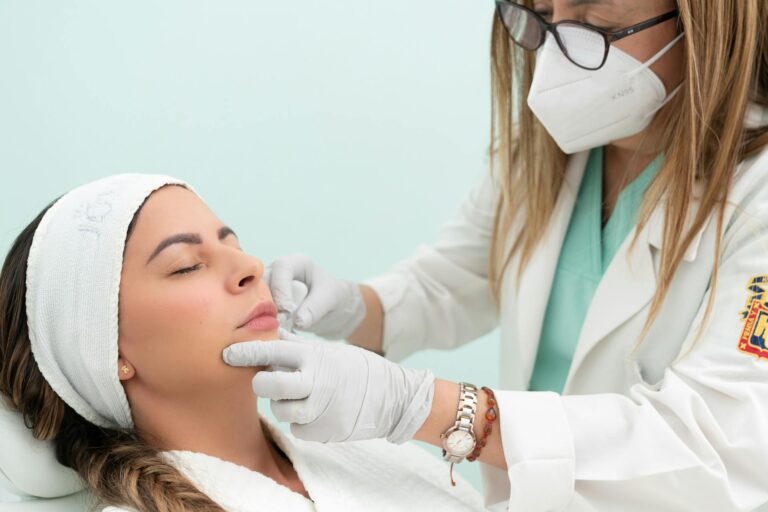
Excessive sweating, known as hyperhidrosis, can be a challenging and often embarrassing condition that impacts daily life. Fortunately, Botox has emerged as an effective treatment option for individuals dealing with this issue.
This article will explain how Botox can help with excessive sweating for UK patients. It will also outline who can benefit from its use, discuss potential side effects, and set realistic treatment expectations. Additionally, alternative options will be explored, along with tips for finding a qualified provider in the UK.
Through this discussion, you will discover how Botox can help restore confidence and comfort in your everyday activities.
What is Botox?

Botox, a widely recognised aesthetic procedure, is a medical treatment that employs botulinum toxin to temporarily diminish the appearance of wrinkles while also addressing various medical conditions, such as excessive sweating, known as hyperhidrosis.
In the field of dermatology, Botox is well-regarded for its ability to deliver both cosmetic enhancement and therapeutic benefits, making it a popular choice for patients in the UK who wish to improve their quality of life.
The treatment functions by blocking nerve signals to the sweat glands, resulting in reduced sweating in areas such as the underarms, palms, and face.
How Does Botox Work for Excessive Sweating?
Botox is an effective treatment for excessive sweating as it blocks the nerve signals that communicate with the sweat glands, thereby reducing sweat production in specific areas.
This procedure is particularly beneficial for individuals dealing with hyperhidrosis, providing temporary relief when traditional antiperspirants fail to deliver sufficient results.
In addition to treating excessive sweating, Botox has proven effective in helping migraines by relaxing the muscles and reducing the frequency and severity of headache episodes. Its versatility extends further, with Botox for men becoming increasingly popular for addressing both medical concerns like hyperhidrosis and cosmetic goals such as wrinkle reduction.
Clinical studies have demonstrated its effectiveness, making Botox a trusted option for patients in the UK seeking to overcome the physical, psychological, and social challenges associated with these conditions.
Who Can Benefit from Botox for Excessive Sweating?
Botox for excessive sweating can be beneficial for many individuals, especially those diagnosed with hyperhidrosis, which causes abnormal sweating in areas such as the armpits, palms, feet, and face.
In the UK, patients seeking a non-surgical solution may find relief through a personalised treatment plan created with the guidance of a healthcare professional or dermatologist. These professionals will conduct thorough sweat assessments and take the patient’s medical history into account before proceeding.
Many patients often share testimonials that highlight significant improvements in their confidence and emotional well-being after undergoing treatment.
What Are the Side Effects of Botox for Excessive Sweating?
Whilst Botox is typically regarded as a safe option for treating excessive sweating, it is important for patients to be aware of potential side effects prior to undergoing the treatment.
Common side effects can include temporary skin reactions such as redness or swelling at the injection site. In rare instances, more significant symptoms may occur. Therefore, it is essential to have a comprehensive consultation with a healthcare professional.
They can assist patients with allergy testing and manage any side effects, ensuring a safe and effective treatment experience.
Are There Any Risks for UK Patients?
For patients in the UK considering Botox for excessive sweating, it is essential to understand the associated risks in order to make an informed decision about the treatment. While most individuals tolerate the procedure well, there may be instances of adverse reactions or complications, especially if a thorough consultation and review of medical history are not conducted beforehand.
It is important for patients to discuss potential risks with their healthcare provider, who can offer insights and recommendations tailored to their specific needs.
Some specific risks that may arise include:
- Localised pain at the injection site
- Muscle weakness
- Allergic reactions, which could be more pronounced in individuals with certain pre-existing conditions
Being transparent about medical history is crucial, as this information can greatly influence the likelihood of complications. Healthcare providers play a vital role in assessing these risks, ensuring that each patient is well-informed about potential side effects and what to expect after treatment.
Engaging actively during consultations not only fosters a sense of give the power toment but also prioritises safety, paving the way for a more positive experience with the treatment.
What to Expect During a Botox Treatment for Excessive Sweating?
During a Botox treatment for excessive sweating, patients can expect a straightforward outpatient procedure that usually involves minimal discomfort and a swift recovery.
Before administering the Botox injections, a healthcare professional may apply local anaesthesia to enhance comfort. Following this, the professional will carefully inject the Botox to target the sweat glands in the affected areas.
After the procedure, patients will receive aftercare instructions to ensure a successful recovery and achieve optimal results, allowing them to confidently resume their daily activities.
How Long Do the Effects of Botox for Excessive Sweating Last?
The effects of Botox for excessive sweating typically last between three to six months, offering patients temporary relief and notable improvements in their quality of life.
As the effects begin to diminish, many patients choose to schedule follow-up appointments to maintain their results, which helps ensure their ongoing satisfaction with the treatment outcomes.
It is worth noting that this duration can vary depending on individual factors, such as how often they receive treatment and the specific areas being addressed.
How Often Should Botox Treatments Be Done?

The frequency of Botox treatments for excessive sweating can vary based on individual needs and the effectiveness of prior sessions. Generally, patients might anticipate returning for follow-up treatments every three to six months to achieve optimal results.
However, this schedule can be adjusted according to personal experiences and the guidance of their healthcare provider. Continuous patient education plays a crucial role in determining the most suitable treatment plan, tailored to address specific sweating triggers and lifestyle considerations.
What Are the Alternatives to Botox for Excessive Sweating?
For those exploring alternatives to Botox for excessive sweating, there are several treatment options available that can address various needs and preferences.
These alternatives range from clinical-strength antiperspirants to oral medications specifically designed to reduce sweating. Additionally, iontophoresis is an option; this procedure utilises electrical currents to interrupt sweat gland activity.
In more severe cases, individuals may consider surgical options like sympathectomy, which offers a more comprehensive approach to effectively managing hyperhidrosis.
1. Antiperspirants
Antiperspirants often serve as the first line of defence for individuals dealing with excessive sweating, providing a topical solution that can be quite effective for mild to moderate cases. These products function by blocking sweat glands with aluminium-based compounds, offering a level of moisture control that can enhance skincare routines and boost confidence in social situations.
While antiperspirants are beneficial, their effectiveness may be limited for those experiencing severe hyperhidrosis, in which case clinical-strength options may be necessary. The application process generally involves applying the product to dry skin before bedtime, allowing adequate time for the active ingredients to penetrate the skin and form a blocked pathway to reduce perspiration.
Although antiperspirants can significantly alleviate symptoms, some individuals might discover that treatments such as Botox provide more comprehensive results for persistent sweating. Botox targets the nerves that trigger sweat production, offering an alternative solution.
Ultimately, a combination of clinical-strength antiperspirants and alternative treatments like Botox may provide a more holistic approach to sweat management, tailored to meet individual needs.
2. Oral Medications
Oral medications, such as anticholinergics, can be prescribed to help manage excessive sweating by blocking the neurotransmitters that activate sweat glands. While these medications may offer relief, it is important for patients to discuss potential side effects with their healthcare provider to ensure they are fully informed about their treatment options.
Along with anticholinergics, other oral medications such as beta-blockers and certain antidepressants can also assist in controlling sweat production by addressing the underlying anxiety or panic that often exacerbates the condition. Understanding how these medications work is vital, as their effectiveness can vary based on individual circumstances.
Potential side effects may include dry mouth, blurred vision, or even more serious reactions, which underscores the importance of comprehensive consultations with healthcare professionals.
By prioritising patient education, individuals can take proactive steps to manage their symptoms while carefully weighing the benefits and risks associated with each medication. This approach give the power tos them to make informed decisions regarding their health.
3. Iontophoresis
Iontophoresis is a non-invasive treatment option for excessive sweating that utilises electrical currents to temporarily inhibit sweat gland activity. This method proves particularly effective for individuals experiencing sweating in the palms or feet, offering a practical alternative for those wishing to manage hyperhidrosis without resorting to surgical solutions.
The procedure typically involves regular sessions, often recommended two to three times per week initially, followed by maintenance treatments every few weeks to months, based on individual responses.
When compared to Botox— which involves injections that can last for several months—iontophoresis presents a less invasive option with fewer side effects. While both treatments aim to reduce sweat production, the decision may depend on various factors such as comfort level, cost, and treatment longevity.
Individuals considering this approach should consult a qualified professional to develop a tailored plan that addresses their specific needs and conditions.
4. Surgery
In cases of severe excessive sweating where other treatments have not been effective, individuals may consider surgical options such as sympathectomy, which can provide a more permanent solution. This procedure involves cutting the nerves responsible for sweat production, offering significant relief. However, it is essential to have a comprehensive understanding of the recovery process and the potential complications involved.
Another option includes endoscopic thoracic sympathectomy (ETS), which is a less invasive procedure that can yield impressive results for many patients. Each of these surgical methods comes with its own set of risks, including infection, compensatory sweating, and respiratory complications, all of which should be thoroughly discussed during pre-operative consultations.
Patient education plays a crucial role in ensuring that individuals are aware of both the benefits and the potential downsides of these procedures, allowing them to make well-informed decisions. Ultimately, consulting with qualified healthcare professionals who specialise in hyperhidrosis can help streamline the decision-making process and determine the best course of action tailored to each person’s specific situation.
How to Find a Qualified Botox Provider in the UK?

Identifying a qualified Botox provider in the UK is essential for ensuring a safe and effective treatment experience.
It is advisable for patients to research specialised clinics staffed by experienced dermatologists or aesthetic medical professionals who have expertise in administering Botox for excessive sweating.
Additionally, verifying regulatory approvals, reading patient reviews, and ensuring transparency regarding consultation fees can significantly aid in making an informed decision.
What Is the Cost of Botox for Excessive Sweating in the UK?
The cost of Botox for excessive sweating in the UK can vary considerably due to several factors, including the specific treatment area, the provider’s level of expertise, and the individual needs of the patient.
Typically, prices can range from a few hundred to over a thousand pounds. It is also important for patients to consider additional expenses, such as consultation fees, as well as the possibility of insurance coverage, which should be explored prior to undergoing treatment.
Frequently Asked Questions: How Botox Can Help with Excessive Sweating for UK Patients
What is Botox and how does it help with excessive sweating?
Botox is a neurotoxic protein that is commonly used for cosmetic purposes, but it can also be used to treat medical conditions such as excessive sweating. Botox blocks the signals that cause the sweat glands to produce sweat, resulting in reduced sweating.
Is Botox an effective treatment for excessive sweating?
Yes, Botox has been proven to be a highly effective treatment for excessive sweating in UK patients. In clinical studies, it has been found to significantly reduce sweating in the underarms, hands, feet, and other areas of the body.
What areas of the body can be treated with Botox for excessive sweating?
Botox can be used to treat excessive sweating in various areas of the body, including the underarms, palms, soles of the feet, scalp, and forehead. It can also be used to treat hyperhidrosis, a medical condition that causes excessive sweating in certain areas of the body.
How long does the treatment with Botox for excessive sweating last?
The effects of Botox for excessive sweating typically last for 4-6 months. After this time, the treatment can be repeated as necessary to maintain the results. However, some patients may experience longer-lasting results with subsequent treatments.
Are there any side effects associated with Botox for excessive sweating?
As with any medical treatment, there is a risk of side effects with Botox for excessive sweating. However, these are usually mild and temporary, and may include bruising, swelling, and minor discomfort at the injection site. Rarely, there may be more serious side effects such as muscle weakness or difficulty breathing.
Is Botox for excessive sweating covered by insurance in the UK?
In most cases, Botox for excessive sweating is not covered by insurance in the UK, as it is considered a cosmetic treatment. However, if you have a medical condition such as hyperhidrosis, your insurance may cover the cost of the treatment. It is best to check with your insurance provider for specific coverage information.






